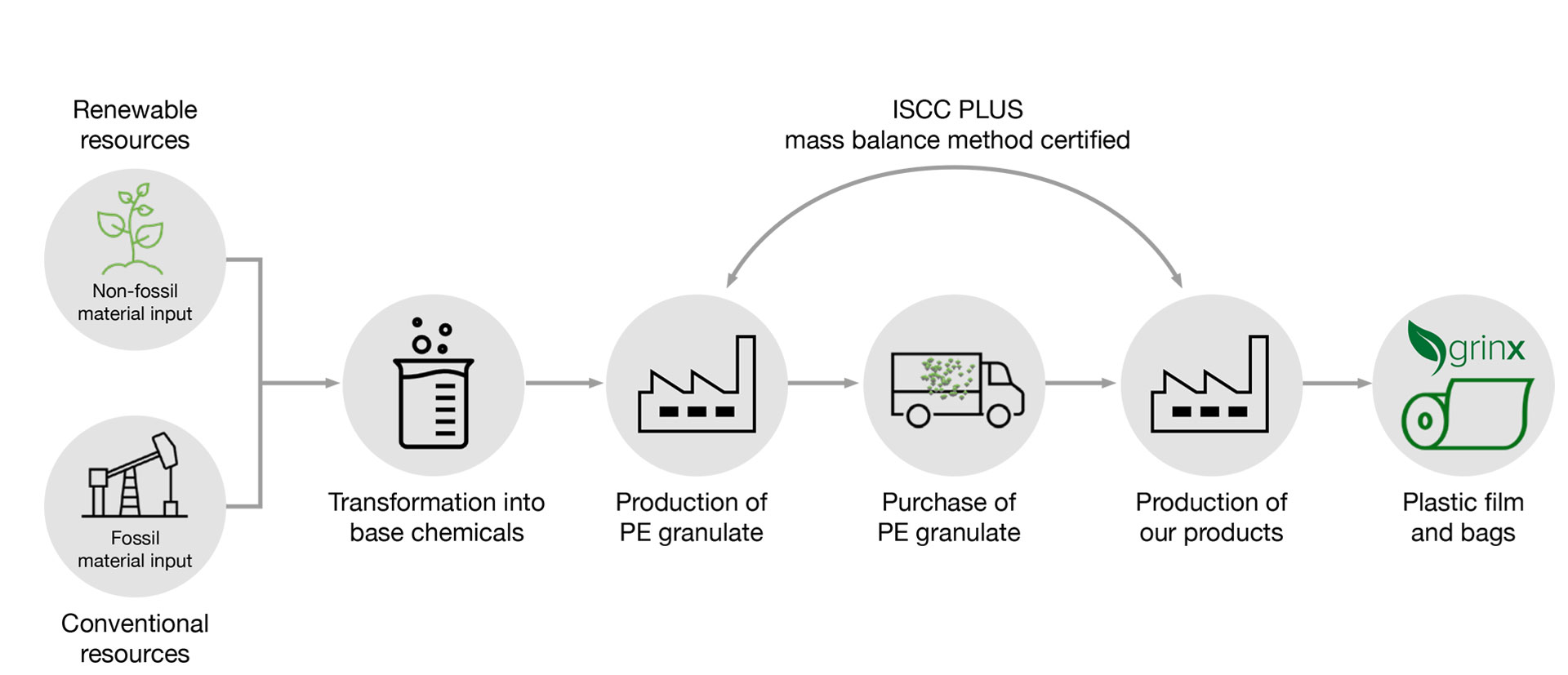grinx - our own brand for more sustainability
A perfect solution for everyone! We created the grinx brand with this intention.
Our product range under the grinx name offers you real more sustainable alternatives to many conventional disposable products.
Do you like to hold parties outdoors? Or you generally spend your time out in nature? Are you planning a celebration and want to serve your gourmet food attractively? Then we have truly more sustainable alternatives to regular disposable tableware. Like our palm leaf tableware! It not only optically differentiates itself from all other tableware, but is incomparable in use. Have you heard of sugar cane bagasse? Interested? Then have a look at our high-quality tableware made of sugar cane bagasse. A plate full of delicious food naturally requires a tool to get it to your mouth. Exactly - cutlery! That's why we offer our top wooden cutlery. A party without drinks is like a party without guests. With our paper drinking straws we offer you the perfect straw for a long, pure enjoyment of your drink. However we want to note, that reusable products are preferred over disposable products whenever possible. If it has to be disposable, make it QuickPack.
Sugar cane bagasse tableware
What is sugar cane bagasse?
So-called bagasse is the fibrous mass that is left over after pressing the sugar cane in the production of sugar from sugar cane. On average, 300 kilogrammes of bagasse are created per tonne of harvested sugar cane. Often, the bagasse is used as combustible material to create process heat and electricity.
Why make dishes out of sugar cane bagasse?
Tableware made of the renewable raw material “sugar cane bagasse” offers you a more sustainable option for serving your food. Our motivation is to offer you a products that is more environmentally-friendly and at the same time practicable.
How do we make our tableware?
The bagasse (fibrous residue) is mixed with water to create a pulpy mass for the production of our tableware. Then this mass is moulded and pressed together through high temperature and increased pressure. So we can produce various moulded items, like our plates and bowls.
A constantly renewable raw material
As a renewable raw material, sugar cane and thus the bagasse are a nearly endlessly available raw material. The global harvest quantity was about 1.87 billion tonnes of sugar cane in 2020.
Advantages of the by-product
Because bagasse is a by-product of sugar cane production, no extra cultivation of the sugar cane is required, and thus is not in direct competition with foodstuff production. So an existing raw material is sensibly reprocessed, value added, so to speak. Thus there is sensible value creation for the bagasse, because only after use of our tableware is the raw material finally disposed of. Thus the bagasse products are preferable to products made of finite raw materials.
Instead of wood cellulose, bagasse cellulose (fibres) are used for the production of our tableware. Thus we contribute to sparing the forests, because an available raw material (bagasse) is materially reprocessed and in this respect is more ecological than paper products.
Another advantage is the ability to compost bagasse products. We want to instruct you on the responsible disposal of our products (Follow the guidelines of the waste disposal company). If you have your own compost, you can compost our bagasse products there.
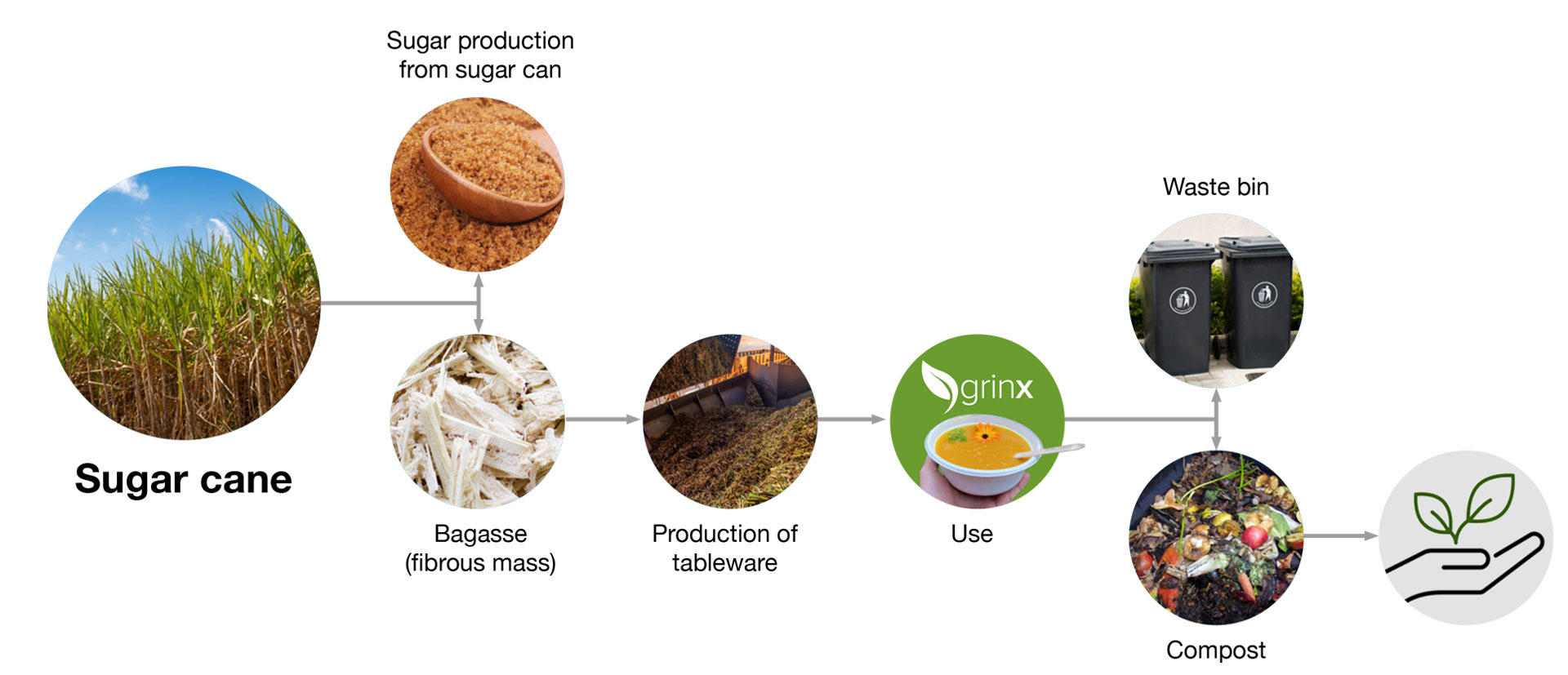
Palm leaf tableware
Why tableware made of palm leaves?
Tableware made of the renewable raw material “palm leaves” offers you a more sustainable option for serving your food. Our motivation is to offer you a products that is more environmentally-friendly and at the same time practicable.
Where do the palm leaves come from?
We use palm leaves for our palm leaf tableware that comes from so-called agricultural waste. The palms drop their leaves at regular intervals and are thus sustainably available because the palms do not have to be felled for this. After collection and storage, the palm leaves are washed and then dried.
How do we make our tableware?
The dried, untreated palm leaves are pressed into shape for the production of the tableware. This pressing process is performed at high temperature (approx. 100 °C). After pressing, the edges of the tableware are cut accordingly and adapted to the final design.
A constantly renewable raw material
As a renewable raw material, palm leaves are a nearly endlessly available raw material. Especially because the entire palm plant does not have to be felled to collect the leaves.
Advantages of the by-product
Palm leaves are not in competition with foodstuff or feed production, because they are cannot be eaten or used as feed. As so-called agricultural waste, the palm leaves are transformed into high-quality disposable tableware, which otherwise would remain in the field or even burnt. This is consistent with our idea of sustainability, creating value from a seemingly worthless material.
A significant advantage is the ability to compost palm leaf products. However, we want to instruct you on the responsible disposal of our products (Follow the guidelines of the waste disposal company). If you have your own compost, you can compost our palm leaf products there.
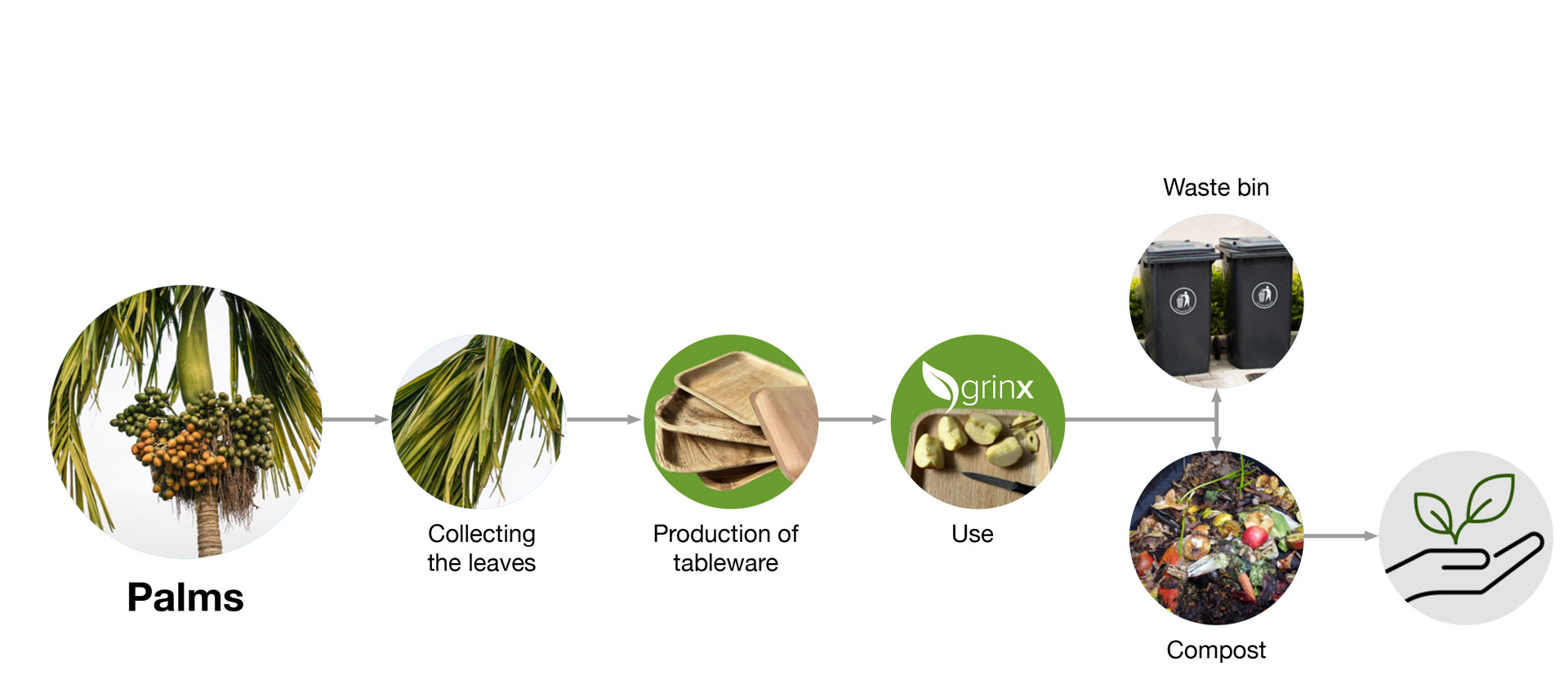
Wooden cutlery
Why wooden cutlery?
Cutlery made of the renewable raw material “wood” offers you a more sustainable alternative to regular disposable cutlery. Our motivation is to offer you a products that is more environmentally-friendly and at the same time practicable.
“Carved” from which wood?
We use FSC® certified wood for our wooden cutlery (FSC®-C100657).
How do you make wooden cutlery?
After the wood harvest, the trunks are stripped and sawn to a certain size for processing. Then wood veneers are created from them. Our wooden cutlery is created from these wood veneers in many individual production processes.
A constantly renewable raw material
We know that wood is a renewable raw materials and endlessly available with responsible and sustainable forest management. This is also guaranteed through our exclusive use of FSC® certified wood.
Advantages of wood as a raw material for cutlery
Wood has many advantages over other raw materials for the production of cutlery. Wood is available in many countries around the world and thus has short transport paths within the value added chain. The wood does not have to be specially treated or mixed with water or even chemicals to form the cutlery, which saves resources. Wood is a rotting natural product that naturally biodegrades. Therefore, our wooden cutlery can also be composted. However, we want to instruct you on the responsible disposal of our products (Follow the guidelines of the waste disposal company).
Additional advantages of wooden cutlery
Our wooden cutlery keeps its shape, is break-resistant and has no splinters. In addition, our wooden cutlery has a mostly neutral flavour and aroma. If you have your own compost, you can compost our wooden cutlery there. All of this makes our wooden cutlery the perfect all-rounder for your next celebration.
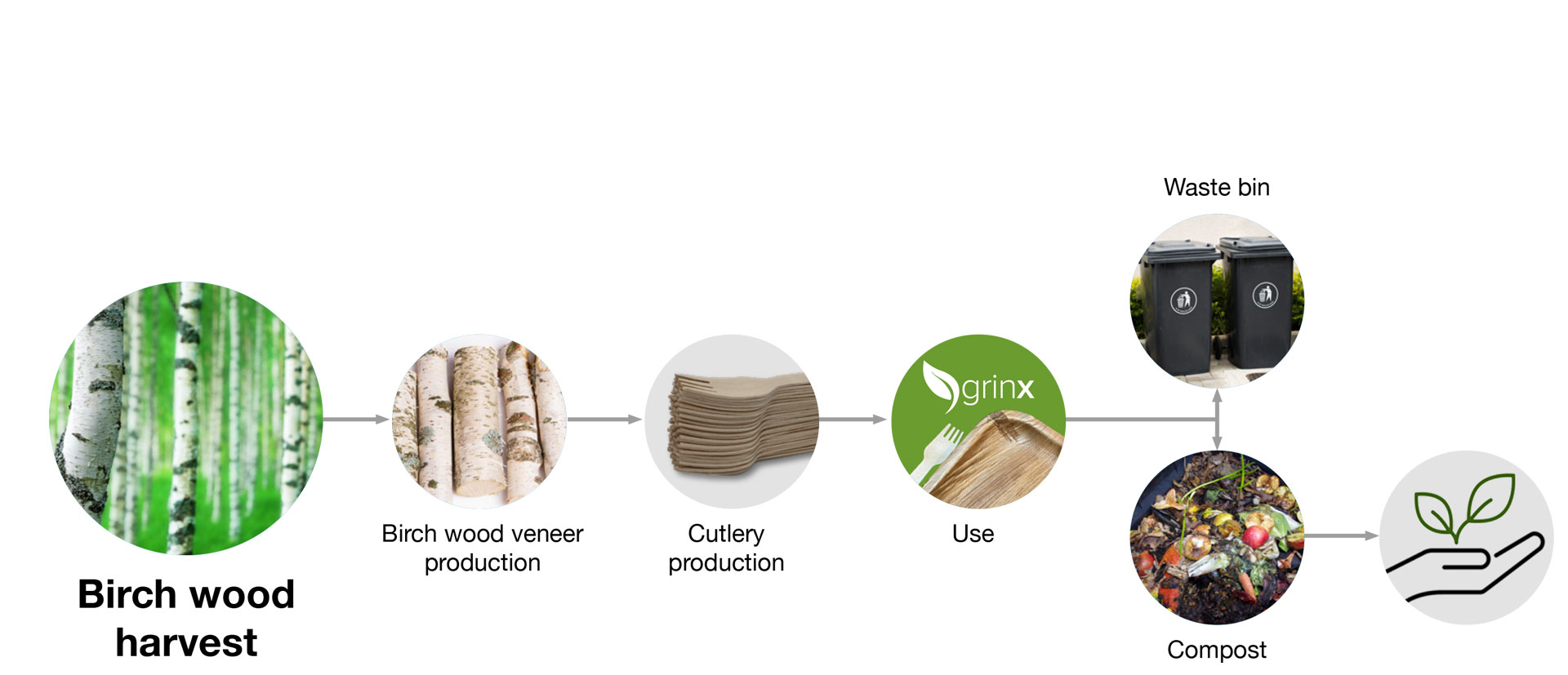
Paper drinking straws
Why paper drinking straws?
Our drinking straws of the renewable raw material “paper” are a strong alternative to regular straws. Our motivation is to offer you a products that is more environmentally-friendly and at the same time practicable.
How do we create our paper drinking straws?
We use paper from FSC® certified wood for the production of our paper drinking straws (FSC®-C100657). By adhering individual strips of paper, we achieve the stable shape of the straws. We have many bright colours and colour combinations in our range, so you'll always find the right drinking straw. If it needs to be even more individual, please contact us.
A constantly renewable raw material
As a renewable raw material, wood and thus paper are a nearly endlessly available raw material. Through FSC® certification, the forests are demonstrably responsibly managed to guarantee sustainable availability.
Advantages of paper drinking straws
If you inadvertently bite down on it, normally nothing happens, which might not be the case with rigid and hard straws. Very beneficial for children. Due to the ability to be composted, inadvertently lost paper drinking straws are not as much of a problem as conventional plastic straws. We want to instruct you on the responsible disposal of our products (Follow the guidelines of the waste disposal company). If you have your own compost, you can compost our them there. Even better if you dispose of them in the paper bin for recycling, if they aren't too dirty.
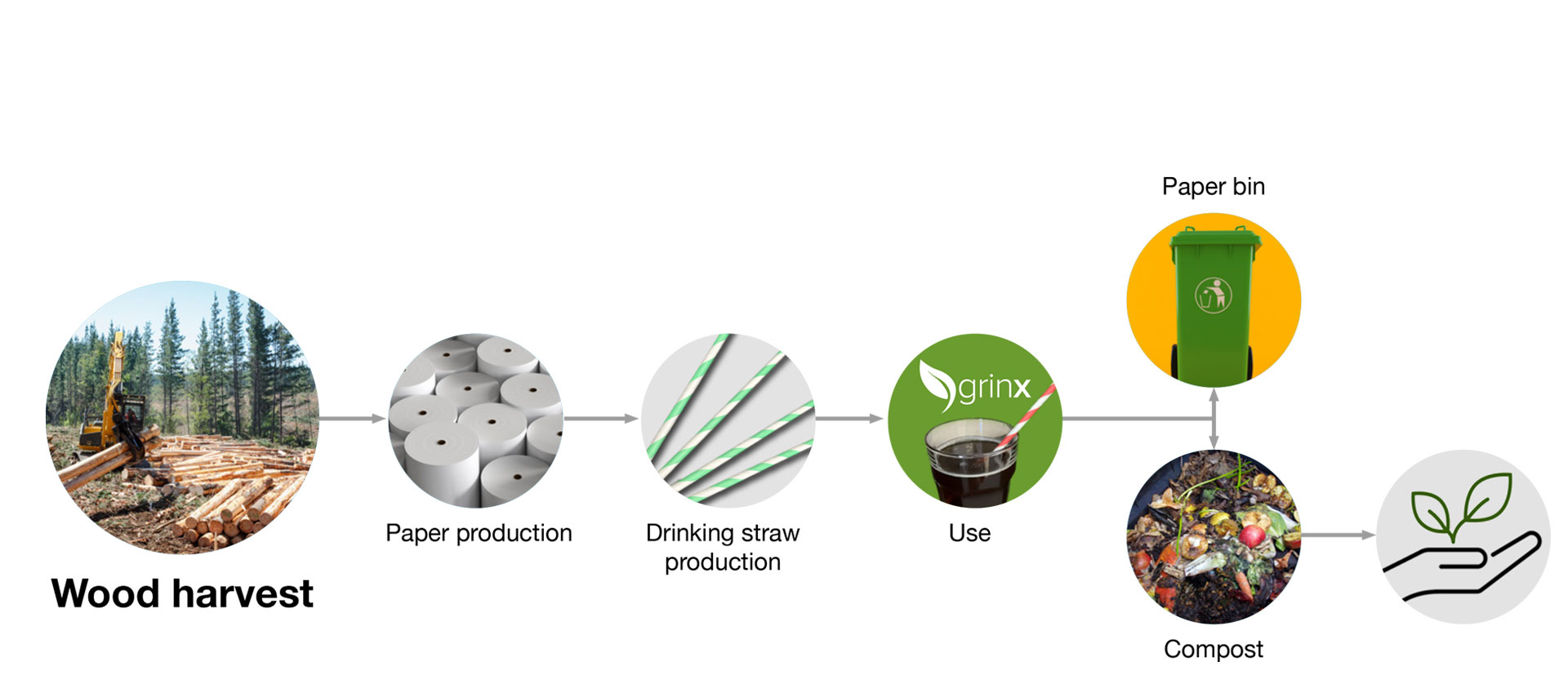
Plastic products with recycled renewable resources
Why produce products with recycled renewable resources?
Plastic film products such as freezer bags and cling film that are made with recycled renewable resources spare fossil-based resources. In addition, recycled renewable resources also spare additional resources because they have already fulfilled another use and at the end are recycled and thus create added value.
What are recycled renewable resources?
These are materials of plant origin and come from the recycling process.
What does “Certified according to the ISCC PLUS Mass Balance Method” mean?
The plastic granulate we purchase for the production of these products (grinx freezer bags and grinx cling film) is certified by the ISCC =International Sustainability und Carbon Certification) and thus ensure that the commended materials are actually used in production.
The mass balance method means that the various input materials are mixed together in production. For example, recycled renewable resources together mixed with other materials (including fossil-based) to make plastics. Through the mixing of the various input materials, the physical composition of the output material (the plastic granulate) cannot be specifically determined at the end. Because the non-fossil input (from recycled renewable resources) is often a small part of the total input, one uses the mass balance method, in which the calculation of the output (the plastic granulate, is assigned to a share of non-fossil material (= recycled renewable resources). In this way it is possible to offer products that promote the use of alternative resources (such as renewable raw materials).
How do we create our products from this certified plastic granulate?
In the production of these products from certified plastic granulate there is no difference to the conventionally produced plastic granulate. The plastic granulates used in the film production behave the same.
Advantages of ISCC PLUS Mass Balance Method certified products
Protecting resources, because renewable resources substitute for fossil-based resources and thus enable more sustainable production. Improved ecological properties compared to conventionally produced plastics from fossil resources. Traceability of the materials within the supply chain is possible through certification and guarantees the origin of the material.
